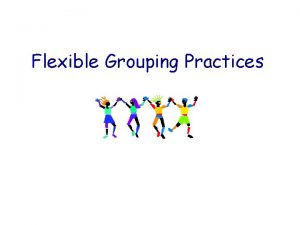Strategic Grouping Strategies for Complex Talk Complex Text


















- Slides: 18

Strategic Grouping Strategies for: Complex Talk Complex Text Complex Tasks Wendy Mc. Cormick, Instructional Coach, FUSD

Today’s Outcomes 2 Identify appropriate data to consider when grouping students. Discuss classroom management considerations when working in partners and groups Practice creating student partnerships and small groups

Partner Clocks 3 Locate a Mitochondria partner. Write your new partner’s name on the line in the box. What types of partner work have you seen in classrooms so far? Pair share Peer editing Partner Reads

Partner Clocks 4 Locate a Chloroplasts partner. Write your new partner’s name on the line in the box. What types of group work have you seen in classrooms so far? Jigsaw Projects Consensus

Partner Clocks 5 Locate a Nucleus partner. Write your new partner’s name on the line in the box. What have you seen that worked well?

Partner Clocks 6 Locate a Cell Wall partner. Write your new partner’s name on the line in the box. What have you seen that didn’t go exactly as planned? What might have helped? ?

Partner Clocks 7 Vocabulary Practice Partners: Homogeneous Heterogeneous Self-selected

8 Quality Structured Interaction Strategic student combinations � Pairs, trio or quads � Personalities, language proficiency, achievement Equal Participation � Time or Turns � http: //www. online-stopwatch. com/ No Ho gs & N Simultaneous Interaction o. L og s � At least 50% of class participating at once Group Accountability Individual Accountability

Foundations of Interaction 9 Management: Classroom & Group Norms � Established early in the year: CHAMPS Posters � Consistently followed and revisited as needed � Considerations: Type and Purpose of Activity Partnering/ Grouping Quiet Signals Directions Seating & Movement Product or Share Out

Talmudic Pair Strategy 10 Meet with your Cell Wall Partner. Read the Strategic Groups handout using the Talmudic Pair strategy: � Partner A reads the first section aloud � Partner B underlines or annotates text � Partner B asks Partner A, “What does that mean? ” � Partner A paraphrases the text information � Partner B may ask clarifying questions or add to the paraphrase. � Partners switch roles and read the next section

Creating Strategic Partner Sets Analyze a variety of student data to create: �Homogeneous partnerships �Heterogeneous partnerships Assign partners to one or two squares on the partner clock. Example: Chloroplast Partner = Homogeneous Cell Wall Partner = Heterogeneous Students self-select remaining two partners

Strategic Partners 12 Meet with your Mitochondria partner Analyze the Sample class data Create a set of homogeneous partnerships Create a set of heterogeneous partnerships

Debriefing 13 Meet with another group of two Discuss the criteria each used for partnering There are many ways to organize

Practice for Partnering 14 Meet with your Nucleus Partner Sort the assignments and determine which partner you would have students meet: � Homogeneous partner � Heterogeneous partner � Self-selected partner

Creating Small Groups 15 Always heterogeneous � Never more than 5 or less than 3 � 1 High/1 Low/1 -2 Basic Everyone has a unique contribution to the task � Individual � Group Accountability

Creating Cooperative Groups 16 Considerations for grouping and differentiation: � Division of the work � Strengths and Challenges of individual students � Personalities: shy, boisterous, team player vs. resistant � Language proficiencies � Special populations: English Learners, Special Education

Creating Cooperative Groups 17 Meet with your Chloroplasts Partner Using the Sample Data, organize the class for the following group project that will take one week of class time: Groups will research a topic of social relevance: Example: poverty, teen pregnancy, childhood obesity Divide the global topic into 3 -4 subtopics: Ex. Causes, Effects, Cures Each member writes a one page, double-spaced paper on their section using information gathered from a minimum of 3 sources Create a class presentation: Poster 10 -15 minute talk (all members must speak) 5 minute Question and Answer session

18 Questions?
 Text to text text to self text to world
Text to text text to self text to world Jag har gått inunder stjärnor text
Jag har gått inunder stjärnor text Flexible grouping for gifted students
Flexible grouping for gifted students Talk read talk write
Talk read talk write Amateurs talk strategy professionals talk logistics
Amateurs talk strategy professionals talk logistics The words use are not
The words use are not Directional strategies in strategic management
Directional strategies in strategic management Strategies in action in strategic management
Strategies in action in strategic management Intensive strategies in strategic management
Intensive strategies in strategic management Functional strategies in strategic management
Functional strategies in strategic management Strategic fit vs strategic intent
Strategic fit vs strategic intent Strategic substitute
Strategic substitute Strategic management and strategic competitiveness
Strategic management and strategic competitiveness Cultural aspects of strategy choice
Cultural aspects of strategy choice Isabel beck
Isabel beck Text n talk
Text n talk Iso 22301 utbildning
Iso 22301 utbildning Novell typiska drag
Novell typiska drag Tack för att ni lyssnade bild
Tack för att ni lyssnade bild



































